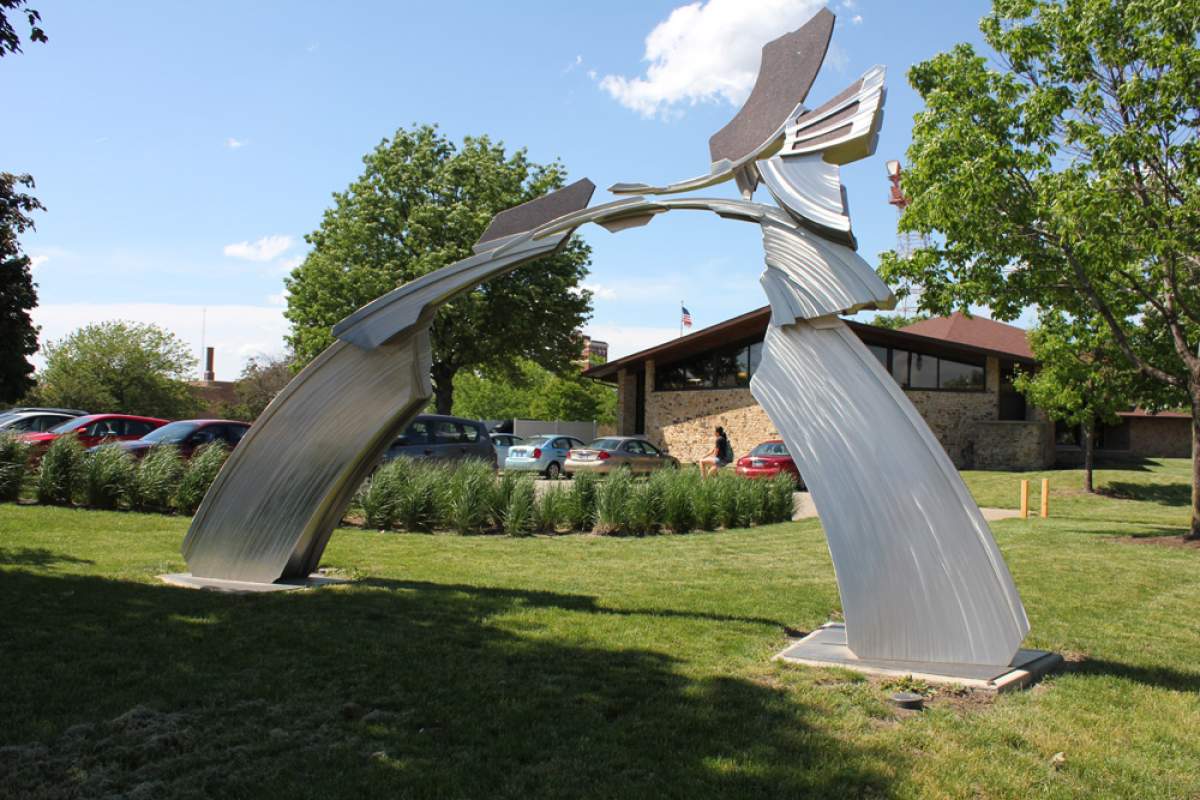
Around Terre Haute, in parks and in front of public buildings, you can see the work of Wabash Valley Art Spaces.
Their collection of sculptures ranges from realistic bronze statues to whimsical contemporary works. Most of the work is concentrated downtown, and the group hopes it will invite visitors back downtown for work and play.
A Mind For Art And Planning
There are two things that make Mary Kramer good at her job: she knows art, and she knows how to integrate it into the city.
Kramer heads up Wabash Valley Art Spaces, and since 2007 the organization has installed 12 sculptures in Terre Haute. Their most recent installation is a sculpture called Renewal, a twelve-foot tall structure with blue glass marbles nestled in wire cages.
It's shaped like a sycamore leaf, the symbol and mascot of Indiana State University athletics. But, as Kramer says, "what's interesting about it is if you see it from way over there, or coming down that way, it's something different. There's a lot of change in the way you experience it."
Renewal is going to get the full treatment from Kramer's organization, with lighting and landscaping that will turn the concrete slab in front of the ISU Foundation building into an inviting plaza.
Art Spaces is a nonprofit that commissions public art, pays for it, and then gives it to an organization to install in its public space. The group's mission is to beautify Terre Haute and make public art more accessible.
Kramer works hard to make sure all of the sculptures are integrated into the city's landscape. Gatekeeper stands at the entrance of the city's arts corridor, in front of the Vigo County Public Library. It's made with sweeping stainless steel and deep Dakota mahogany granite, and acts as an arch leading to the museums, galleries, and performance spaces of Seventh Street.
At The Crossroads, And Beyond
Down the street at the crossroads-Seventh Street and Wabash Ave, where north, south, east and west highways used to meet-another piece encourages the public to interact with a historic Terre Haute figure, poet Max Ehrmann.
"That whole corner, you know, all of the landscaping and benches was not there at all," Kramer says. She and her board members raised the money and in-kind donations to turn a corner of a parking lot into a small park, where visitors can have a seat next to Terre Haute's most famous literary figure.
Sometimes they sit and read, other times they take silly photos for their Christmas cards. But that's all part of the plan.
"It's happening more and more that art is playing this role in enlivening spaces and helping people understand more about the community and the heritage, and exposing people to what art can do," says Kramer.
Some of the other pieces are integrated into their surroundings so their presence seems almost a given. Kramer and her committee chose the Chorus of Trumpets for the ISU campus because it echoes its surroundings and the theme of the performance hall it stands next to.
The artist, Howard Kalish, "came up with this idea of beautiful tinted urethane trumpet shapes, on the end of aluminum poles and it's attached to a stainless steel center," says Kramer. "It really looks to me kind of like a flower popping out of the ground. And it's lit at night so it glows at night. Just beautiful."
The sculpture also sits on a green roof over an ISU computer lab. Like every piece in the collection, Chorus of Trumpets was commissioned with a specific site in mind.
A Revitalization Strategy
Each sculpture Art Spaces commissions is meant to improve and complement its surroundings. Pat Martin, Terre Haute's chief city planner, has worked with Kramer on the project. He sees public art as key to getting people to come downtown.
As Martin describes it, "the strategy in 2000, 2001 was downtown revitalization. At that time downtown Terre Haute was struggling for an identity in that business was very tough during that period."
Kramer agrees, saying that using art as part of a revitalization strategy is "kind of an idea whose time has come. And so for those of us who are fortunate enough to work in communities that are really saying yes, let's do this, I think it's wonderful. People in the arts really seem to be excited by it. I certainly am, or I wouldn't be doing what I'm doing."
Although almost all of the downtown areas designated for public sculptures are full, Kramer's work is far from over.
Next year Art Spaces will be working with several Terre Haute groups on Riverspaces, a project to open up the Wabash riverfront to Terre Haute's residents. There will be parks, environmental art, and pedestrian access to the water, similar to waterfronts in Louisville and Charleston. They're calling it the "Year of the River."






